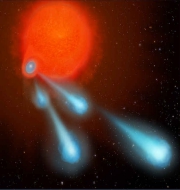Hubble Space Telescope detects Great Balls of Fire
NASA’s Hubble Space Telescope (HST) has detected Great Balls of Fire (GBF), a mysterious super-hot blobs of gas seen near a dying star.
The plasma gas balls were observed near a red giant called V Hydrae, about 1,200 light years away from Earth. Red giants are dying stars that are nearing the end of their fuel supplies and have begun to expand and puff up.
Key Facts
- HST had found that these GBFs from V Hydrae are double the mass of Mars and twice as hot as surface of sun. GBF have continued once every 8.5 years for at least past 400 years.
- They are moving so fast in space that they would take only half an hour cover distance between moon and Earth.
- If scientists are able to discover origin of these balls, it could explain other weird shapes seen in the cloud of gas around dying stars, which is difficult for scientists to explain at present.
About Hubble Space Telescope (HST)
- HST is a space telescope that was launched in 1990 by NASA in collaboration with European Space Agency. It is named after the astronomer Edwin Hubble and is still in operation.
- It is managed by NASA’s Goddard Space Flight Center in Greenbelt, Maryland. Its operations are conducted by Baltimore based Space Telescope Science Institute (STScI).
- It is located in low Earth orbit outside the distortion of Earth’s atmosphere that allows it to take extremely high-resolution images.
- Its successor, James Webb Space Telescope (JWST), is scheduled for launch in 2018.
Month: Current Affairs - October, 2016


